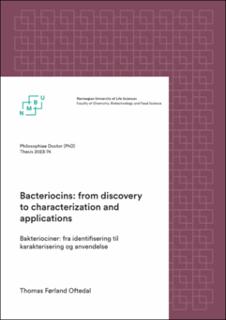| dc.description.abstract | Multidrug resistant bacteria have become a major concern in both human and
veterinary medicine. Due to the waning efficacy of many antibiotics, new
antimicrobial agents are needed. Bacteriocins are ribosomally synthesized
antimicrobial peptides produced by bacteria to kill other bacteria. Bacteriocins are
typically membrane-active antimicrobials with a mechanism of action that differs
from antibiotics and are therefore equally potent against antibiotic-resistant strains
as their susceptible counterparts. Bacteriocins generally exhibit low toxicity, low
bioaccumulation, and a narrow spectrum of inhibition, making them a promising
alternative or supplement to antibiotics.
Papers I-IV focus on the discovery of novel bacteriocins. Paper I describes the
discovery, purification, and initial characterization of a novel bacteriocin, ubericin K.
In this study, samples of raw bovine milk were screened for the presence of bacteria
producing bacteriocins inhibiting Enterococcus faecalis, Streptococcus dysgalactiae,
or Staphylococcus aureus. These species are implicated as the causative agents in
bovine mastitis, and bacteriocins have previously been shown to be able to reduce
the incidence of mastitis in dairy cows. Additionally, S. aureus and E. faecalis are
opportunistic pathogens also in humans. In Paper II, a bacteriocin producer that
inhibited a multidrug resistant strain of E. faecium, an emerging opportunistic
human pathogen, was found. The bacteriocin named vagococcin T was identified as
a two-peptide lantibiotic and shown to be active also against Listeria monocytogenes
and E. faecalis. Paper III describes the techniques and methods used in our
laboratory for purifying and identifying new bacteriocins and investigating their
mode of action. In Paper IV, we show that leaderless bacteriocins can be engineered
to change their target organism and potency. This was achieved by constructing a
library of hybrid peptides consisting of the N- and C-terminal halves of saposin-like
leaderless bacteriocins. We hypothesized that these peptides have N-terminal and C-
terminal halves with distinct properties related to membrane insertion and the
recognition of a molecular target. Using in vitro protein synthesis and spot-on-lawn
assays, we identified novel peptides with a spectrum and potency that differed from
the parental peptides. We believe that these hybrid bacteriocins are good candidates
for future therapeutics and/or probes.
There are some major challenges to the clinical application of bacteriocins, such as
their susceptibility against proteases, low solubility under physiological conditions,
and rapid clearance from blood/plasma. An alternative to using bacteriocins as
therapeutic agents is to use them as “molecular probes” for the detection of their
target organism(s). For example, the bacteriocin enterocin K1 (EntK1) exhibits high
potency only towards E. faecium, a specificity determined by a receptor protein,
RseP, on target cells. The high potency is believed to be due to a high binding affinity
to the receptor.
In Paper V, the interaction between EntK1 and its receptor, RseP, was studied in
detail using sensitivity and binding experiments. In contrast to UbeK and VcnT,
EntK1 is a small, unmodified, and leaderless bacteriocin ideally suited for synthetic
production and chemical modification. In this study, we show that the binding of
EntK1 to cells solely depends on RseP and that the spectrum of activity of EntK1 is
due to the subtle sequence differences in RseP between species.
The potential of EntK1 as a diagnostic “probe” was also explored. Despite recent
advances in clinical and diagnostic technologies, diagnosing a given infection is often
time-consuming and complex. The diagnosis of an infection and identification of the
causative microorganism can often only be obtained by molecular detection or
traditional culture-based techniques. Because of this, infections are frequently
treated blindly with broad-spectrum antibiotics. The unnecessary use of antibiotics
is undesirable due to the spread of resistance and off-target killing of non-
pathogenic (good) bacteria. Rapid and cost-effective diagnostic methods could
reduce health costs and antibiotic use.
In Paper VI, we employed EntK1, which was chemically synthesized with an N-
terminal fluorescent tag, to develop a flow cytometry-based detection method for E.
faecium. The method was shown to be highly specific for E. faecium, which was
detected with higher fluorescent signals than S. aureus and E. coli. Further, the
detection method was evaluated on urine samples containing less than 105 CFU/ml
of bacteria, the laboratory diagnostic criterium for a urinary tract infection. Samples
containing E. faecium were positively identified and could be distinguished from
samples containing S. aureus or E. coli. The work presents a proof of concept for
using bacteriocins as specific probes for rapid detection and diagnosis. | en_US |
| dc.description.abstract | Multiresistente bakterier er blitt et betydelig problem i både human- og veterinærmedisin. På grunn av redusert effekt av mange antibiotika, er det behov for nye antimikrobielle midler. Bakteriociner er ribosomalt-syntetiserte antimikrobielle peptider produsert av bakterier, for å drepe andre bakterier. Bakteriociner er typisk membran-aktive forbindelser med virkningsmekanismer som er forskjellig fra antibiotika. De er derfor like effektive mot multiresistente som antibiotika-sensitive bakterier. Bakteriociner generelt viser lav toksisitet, liten grad av opphoping i miljøet, og de har et smalt hemmingsspekter, Tilsammen gjør dette bakteriociner til et lovende alternativ eller supplement til antiobika. | en_US |

